Aster (missile family)
| Aster | |
|---|---|
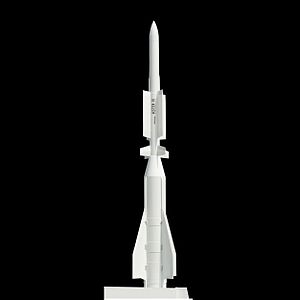 MBDA Aster 30 on display showing attached booster. | |
| Type | Aster 15: Short/medium range anti-aircraft and anti-missile missile. Aster 30: Long range anti-aircraft and anti-missile missile. |
| Place of origin | France / Italy |
| Service history | |
| In service | 2001 |
| Production history | |
| Manufacturer | MBDA / Thales Group / Eurosam |
| Specifications | |
| Mass | Aster 15: 310 kg[1] Aster 30: 450 kg[1] |
| Length | Aster 15: 4.2 m[1] Aster 30: 4.9 m[1] |
| Diameter | Aster 15: 180 mm |
| Warhead | Directed fragmentation. |
Detonation mechanism | Direct contact or proximity.[1] |
| Engine | Solid propellant two-stage rocket. |
Operational range | Aster 15: 1.7–30+ km[1][2] Aster 30: 3–120 km[1][2] |
| Flight altitude | Aster 15: 0–13 km[1] Aster 30: 0–20 km[1] |
| Maximum speed | Aster 15: Mach 3.5 (1,191 m/s)[3] Aster 30: Mach 4.5 (1,531 m/s)[1] |
Guidance system |
|
Launch platform |
|
The Aster missile series, primarily comprising the Aster 15 and Aster 30 are a family of vertically launched surface-to-air missiles.[2] The name "Aster" originates from the mythical Greek archer named Asterion (in Greek mythology), Asterion likewise receiving his name from the ancient Greek word aster (Template:Lang-el), meaning "star". Aster is manufactured by Eurosam, a European consortium consisting of MBDA France, MBDA Italy (combined 66%) and the Thales Group (33%). The missile is designed to intercept and destroy a wide range of air threats, such as supersonic anti-ship cruise missiles at very low altitude (Sea-skimming)[4] and fast flying, high performance aircraft or missiles.
Aster is primarily operated by France, Italy, and the United Kingdom and is an integrated component of the PAAMS air-defence missile system, known in the Royal Navy as Sea Viper. As the principal weapon of the PAAMS system, Aster equips the Type 45 destroyers and the Horizon class frigates. Aster also equips the French and Italian FREMM multipurpose frigates, though they will not be operating as part of a PAAMS air-defence suite.
Although the Aster 30 is anti-ballistic missile capable,[5] an Aster Block 2 BMD (Ballistic Missile Defence) variant of the Aster 30 missile, with Hit-To-Kill and exo-atmospheric capability,[6] is currently being developed.[7]
History
During the 1980s, the predominant missiles in Franco-Italian service were short-range systems such as the French Crotale, Italian Aspide or American Sea Sparrow, with ranges up to a dozen kilometres. Some vessels were also equipped with the American medium/long range Standard. France and Italy decided to start development of a domestic medium/long range surface-to-air missile to enter service in the first decade of this millennium, that would give them comparable range but superior interception capability to the American Standard or British Sea Dart already in service.
Thought was given in particular to the new missile's ability to intercept next-generation supersonic anti-ship missiles, such as the Brahmos missile developed jointly by India and Russia. This allowed the actual systems to have the characteristic of being specialised either in short-to-medium range "point defence" (ships, for instance), or in medium-to-long range "zone defence" (fleets).
In May 1989, a Memorandum of understanding was signed between France and Italy for the development of a family of future surface-to air-missiles. Eurosam was formed shortly afterwards. By July 1995 development had taken shape in the form of the Aster missile and test firing of the first Aster 30 took place. The missile successfully intercepted a target at an altitude of 15,000 m and at speeds of 1000 km/h. A Phase 2 contract was awarded in 1997 at US$1 billion for pre-production and development of the French-Italian land and naval systems.
During development trials between 1993 and 1994 all flight sequences, altitudes and ranges, were validated. This was also the period during which the launch sequence of Aster 30 was validated. In May 1996, trials of the Aster 15 active electromagnetical final guidance system against live targets began. All six attempts were successful. Again during 1997 Aster was extensively tested, this time being pitted against targets such as the C22 target and first generation Exocet anti-ship missiles. In numerous engagements Aster scored direct impacts on its targets. During one such engagement on 13 November 1997 in a strong countermeasures environment, the Aster was not armed with its military warhead so that the distance between the Aster and the target could be recorded. The target (a C22) was recovered bearing two strong cuts due to the fins of the Aster missile.

In May 2001 Aster had again successfully completed the "manufacturer's validation firing test" and was deployed for the first time on the French nuclear-powered aircraft carriers Charles de Gaulle (R91). Again on the 29 June 2001 achieved a successful interception of a Arabel missile at low altitude in less than five seconds. During the same year a target simulating an aircraft flying at speeds of Mach 1 and at an altitude of 100 meters was intercepted by an Aster 15. The first ever operational firing of the Aster missile took place during October 2002 on board Charles de Gaulle. Finally in November 2003 Eurosam was awarded the 3 billion euro Phase 3 production contract which saw full production commence and exports to France, Italy, Saudi Arabia and the United Kingdom.[8] The resulting Aster surface-to-air missile meets inter-service and international requirements, addressing the needs of the land, air and naval forces of France, Italy and the United Kingdom. The decision to base the missile around a common terminal intercept 'dart' to which different sized boosters can be attached has made it modular and extensible.
From 2002 to 2005, the Italian experimental frigate Carabiniere (F581) provided a test bed for live firing trials of the Aster 15 from Sylver A43 launchers with EMPAR and SAAM-it systems, and the trials of Aster 30 from Sylver A50 launchers with EMPAR and PAAMS(E) systems. As of 2012[update], France has spent €4.1bn at 2010 prices on 10 SAMP/T launchers, 375 Aster 30 missiles and 200 Aster 15 missiles.[9] Another 80 Aster 30 and 40 Aster 15 have been bought for France's Horizon-class frigates under a separate programme.[9]
Characteristics
Aster is best described as an anti-missile missile that is capable of intercepting all types of high performance air threats such as; aircraft, UAVs, ballistic missiles, cruise missiles and anti-ship missiles at ranges of up to 120 km.[1] There are currently two versions of the Aster missile family, the short range version, Aster 15 and the long range version, Aster 30. The missile bodies are identical; Their difference in range and intercept speed is because Aster 30 uses a much larger booster. Total weights of the Aster 15 and Aster 30 are 310 kg and 450 kg respectively. Aster 15 has a length of 4.2 meters, rising to just under 5 meters for Aster 30. Aster 15 has a diameter of 180mm.[1]
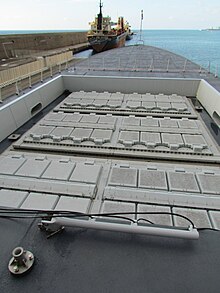
Given the larger dimensions of the Aster 30, a naval based system requires the longer tubes of the Sylver A50 or A70 vertical launching system (VLS). Additionally the American Mark 41 Vertical Launching System can accommodate Aster 30.
Aster 30 is capable of reaching speeds of Mach 4.5 while reaching altitudes of 20 km and is capable of performing aerial manoeuvres greater than 60 Gs giving it a very high degree of manoeuvrability.[10] This is thanks to the combination of aerodynamic control and the direct thrust vector control called "PIF-PAF".[1] Thrust vectors are intentionally located at the missile's centre of gravity maximising responsiveness.[10] This system also prevents a rupture of the missile under high-g maneuvers during trajectory corrections, and allows such maneuvers to be performed without losing aerodynamic performances, improving the precision of the impact on target. A standard launch of the Aster can include 90-degree trajectory changes.[11]
Eurosam describes Aster as a "hit-to-kill Missile Interceptor".[10]
The Aster missile is autonomously guided enabling it to cope with saturated attacks and is equipped with an active RF seeker.[1] The shipboard radar fulfills roles of sentry, meteo, target discrimination, acquisition and chase. When coupled with the advanced PAAMS air-defence system utilizing the SAMPSON and S1850M radars (as found on the British Type 45 destroyers), Aster is capable of simultaneously targeting and engaging multiple targets at once. MBDA states Aster is capable of "Multiple engagement capability with high rate of fire".[1]
Variants
- Aster 15 - Ship point and local area defence
- Aster 30 Block 0 - Ship local and wide area defence
- Aster 30 Block 1 - Ground-based wide area defence capable against 600 km-range ballistic missiles such as Scud-B[12]
- Aster 30 Block 1NT (New Technology) - wide area defence capable against 1500 km-range ballistic missiles[13]
- Aster 30 Block 2 - wide area defence capable against 3000 km-range ballistic missiles[12]
Block 1 is used in the Eurosam SAMP/T system operated by the French Air Force and the Italian Army.[14] As of 2014[update], the development of Block 1NT is being funded by France and Italy.[13] Block 2 would not be delivered until after 2020.[12] In 2016, the UK showed interest in acquiring the Block 1NT version for its Type 45 Destroyers.[15]
Operational history
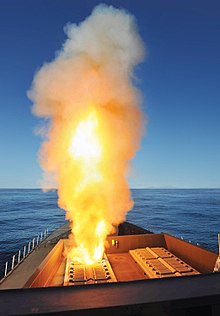
- In April 2008, the Republic of Singapore Navy Formidable class frigate RSS Intrepid shot down an aerial drone off the French port of Toulon during a naval exercise. Then again in 2010, a frigate of the same class, RSS Supreme fired an Aster 15 and shot down an aerial drone off the coast of Hawaii as part of exercise RIMPAC 2010.
- In September 2010, off the Outer Hebrides at the Benbecula ranges, HMS Dauntless (D33) became the first Royal Navy Type 45 destroyer to shoot an Aster missile and hit its target. The target, a 13-foot Mirach drone, can fly more than 600 mph at altitudes from 10 feet to 40,000 feet.[16]
- In May 2011, HMS Daring (D32), the first of the Royal Navy's Type 45 destroyers, fired its Aster missiles for the first time. The shoot took place off the Outer Hebrides at the Benbecula ranges in Scotland. Daring intercepted and destroyed its target, a Mirach drone.[17] Daring was not the first Type 45 to fire its primary weapon. This was due to initial manufacturing defects on a batch of production Aster missiles exported to the UK. The defect was found after consecutive failures during testing, thus stalling the Royal Navy's attempts to fire the Aster missiles during late 2009.[18]
- In December 2011, an Aster 30 missile downed an Israeli Black Sparrow ballistic missile target, the first time an Aster missile had attempted such an engagement.[5]
- In April 2012, the French Navy downed an American GQM-163 Coyote target simulating a sea-skimming supersonic anti-ship cruise missile traveling at Mach 2.5 (3000 km/h) with an altitude of less than 5 metres. The Aster 30 missile was fired by the Horizon-class frigate Forbin (D620); also present during the shoot was Forbin's sister ship Chevalier Paul (D621). It was the first time a European missile defence system destroyed a supersonic sea-skimming "missile". The trial was described as a "complex operational scenario".[4]
- In May 2012, HMS Diamond (D34) was the third Royal Navy Type 45 destroyer to hit its target, a Mirach drone, with an Aster. The firing took place off the Outer Hebrides at the Benbecula ranges in Scotland.[19][20]
- In July 2012, HMS Dragon (D35) was the fourth Royal Navy Type 45 destroyer to hit its target, a Mirach drone, with an Aster. The firing took place off the Outer Hebrides at the Benbecula ranges in Scotland.[21]
- In May 2014, HMS Defender (D36) was the fifth Royal Navy Type 45 destroyer to hit its target, a Mirach drone, with an Aster.[22]
Deployment
Naval systems

- Type 45 destroyer
- Horizon-class frigate
- FREMM multipurpose frigate
- Formidable-class frigate
- Al Riyadh-class frigate
- Charles de Gaulle aircraft carrier
- Cavour aircraft carrier
- Kalaat Béni Abbès Class
Land systems
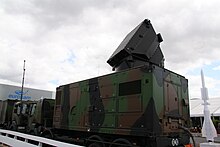
Aster 30 has been successfully incorporated into a land based SAM system, fulfilling the "Ground-based area defence" mission requirement.[23] It comes in the form of the Eurosam SAMP/T (Surface-to-Air Missile Platform/Terrain). The French Ministry of Defence initially placed orders for six SAMP/T Mamba systems for the French Army and six systems for the French Air Force, however by 2012 the order was reduced to ten Mamba systems and all will now be operated by the Air Force. It is intended that they will provide mobile air-defence for strategically important locations at home or abroad - primarily military air bases. SAMP/T is currently equipping five squadrons of air defence (EDSA) in the French Air Force and has been operational since 2010. SAMP/T is primarily mounted on a Renault 8x4 Kerax transporter erector launcher vehicle; it is fitted with eight missiles - all of which can be salvo-fired in under ten seconds.[24]
Eurosam also received an order for six SAMP/T systems for the Italian Army, the first units of which are already in service. It is mounted on Astra 8x8 transporter erector launcher trucks, each truck with eight missiles.[24]
The Republic of Singapore Air Force has ordered an unknown amount of SAMP/T systems to replace their Improved Hawk missiles.[25]
The system is the favorite inside the Swedish Armed Forces to fill the current gap in the country's air defense. The government have decided that a new medium-range system should be acquired.
The system uses a network of sophisticated radars and sensors - including 3D phased array radar - enabling it to be highly effective against all types of air threats.[24] Italy is considering adding enhanced BMD capabilities to the SAMP/T.[26] The SAMP/T uses an upgraded version of the ARABEL long range radar, with improved performance developed under the Aster 30 block 1 upgrade program, in order to extend the system's capability against higher speed targets and higher altitude targets. The SAMP/T system can intercept missiles with a 600 km range (short range ballistic missile targets).[24]
Operators

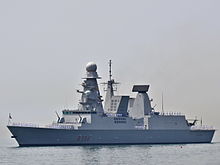

Current operators
Potential operators
See also
- European multilateral defence procurement
- PAAMS
- Anti-aircraft warfare
- Anti-ballistic missile
- Surface-to-air missile
- List of missiles
- RIM-66 Standard
- RIM-67 Standard
- RIM-161 Standard Missile 3
- RIM-162 ESSM
- RIM-174 Standard ERAM
- S-300 (missile)
- S-400 (missile)
- S-500 (missile)
- Arrow (Israeli missile)
- HQ-9
- Barak 8 (missile)
- CAMM (missile family)
References
- ^ a b c d e f g h i j k l m n o p q MBDA - Aster PDF
- ^ a b c Eurosam: Naval Systems - Aster 15 & 30/PAAMS (Official Eurosam website), Retrieved February 2014. "Up to 120 km range"
- ^ http://www.mbda-systems.com/aster-solution-maritime-superiority/aster-15-30/
- ^ a b Interception d’une cible supersonique évoluant au ras de l’eau. (In French)
- ^ a b Ballistic missile intercepted by Aster 30
- ^ https://www.youtube.com/watch?v=xzKiTc-Ngyc
- ^ Aster Block 2/BMD
- ^ Eurosam - Program milestones
- ^ a b "Projet de loi de finances pour 2013 : Défense : équipement des forces" (in French). Senate of France. 22 November 2012. Retrieved 7 November 2013.
- ^ a b c ASTER hit-to-kill Missile Interceptors
- ^ Details of the Asters trajectory change manoeuvre
- ^ a b c Tran, Pierre (12 May 2013). "MBDA Positioned to Score Big in 3 Deals". Defense News.
- ^ a b http://web.archive.org/web/20150330142007/http://www.mbda-systems.com/mediagallery/files/aster-family_background-1402652367.pdf. Archived from the original (PDF) on 30 March 2015. Retrieved 26 November 2015.
{{cite web}}: Missing or empty|title=(help); Unknown parameter|deadurl=ignored (|url-status=suggested) (help) - ^ ASTER - SAMP/T
- ^ https://www.gov.uk/government/uploads/system/uploads/attachment_data/file/505177/UKFRS_security_and_defence_final_2_March.pdf
- ^ Royal Navy - Sea Viper
- ^ MOD - HMS Daring fires Sea Viper for first time, 19 May 2011.
- ^ MBDA reports Aster 30 test success
- ^ MOD - HMS Diamond fires Sea Viper missile for first time, 1 May 2012.
- ^ Diamond fires her main weapon for the first time, 1 May 2012.
- ^ HMS Dragon spits Sea Viper fire
- ^ Defender ready to live up to her name after successful first Sea Viper firing, 16 May 2014
- ^ Aster 30 SAMP/T – Surface-to-Air Missile Platform / Terrain
- ^ a b c d Aster 30 SAMP/T
- ^ "Singapore To Acquire European Surface-To-Air Missile System". Defense News. 16 September 2013. Retrieved 17 September 2013.
- ^ "Italy considers enhancing Aster SAMP/T with anti-ballistic capability."
- ^ http://www.navyrecognition.com/index.php?option=com_content&task=view&id=1985[%2Frtl]
- ^ "DCNS Transfered the FREMM Frigate Tahya Misr to the Egyptian Navy". 24 June 2015.
- ^ Cabirol, Michel (31 May 2012). "DCNS propose la frégate Fremm et le Mistral au Canada" (in French). La Tribune. Retrieved 12 February 2015.
- ^ dismisses NATO allies’ bids, selects Chinese firm for air defense system tender, 26 September 2013.
- ^ [1], 6 June 2015.
External links
- Aster 30 SAMP/T – Surface-to-Air Missile Platform / Terrain on army-technology.com
- SAMP/T Aster 30 Mamba Surface-to-air defense missile system on armyrecognition.com
- Video - HMS Diamond fires Aster 30 missile, 2012
- MBDA Aster 15 & 30 PAAMS
- MBDA Aster 15 SAAM
- Eurosam Aster page
